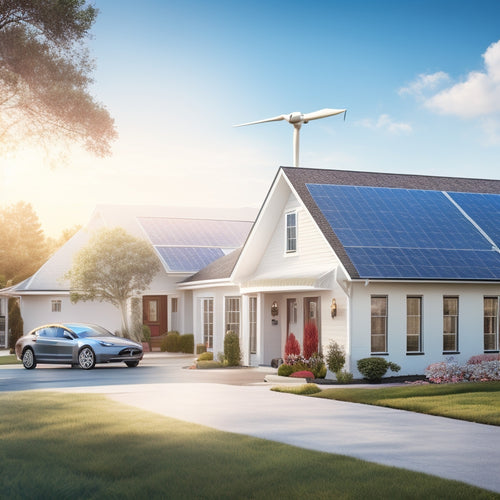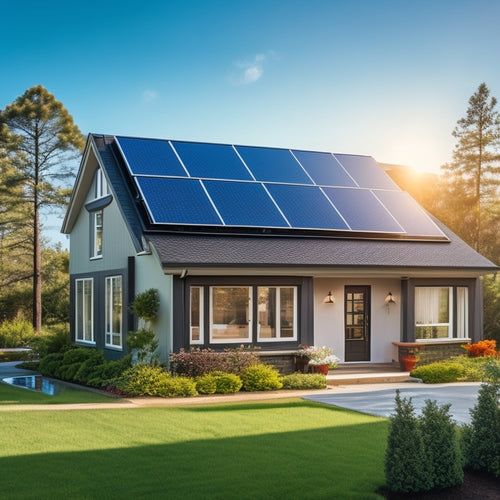
Choosing the Right Residential Solar Energy Storage
Share
When choosing the right residential solar energy storage, you'll want to assess your daily energy consumption, including peak usage hours and seasonal variations, to determine your ideal storage capacity. You'll need to think about your goals, such as powering essential appliances during outages or offsetting peak demand charges. Evaluating different battery technologies, like lithium-ion and lead-acid batteries, and analyzing their integration with your solar panel system is vital. You'll also need to take into account factors like inverter compatibility, energy output matching, and overall system performance. By understanding these key factors, you can make an informed decision that meets your unique energy needs and sets you on the path to a seamless shift to clean energy - and there's more to investigate in this expedition.
Key Takeaways
- Assess daily energy consumption, including peak usage hours and seasonal variations, to determine ideal storage capacity.
- Evaluate solar battery technologies, including lithium-ion and lead-acid batteries, and consider benefits, drawbacks, and environmental impact.
- Size the battery correctly to avoid underperformance or excessive costs, factoring in peak usage periods and future energy needs.
- Ensure compatibility of the energy storage system with the existing solar panel system, including inverter and monitoring system compatibility.
- Consider installation and maintenance costs, warranty options, and support quality when selecting a residential solar energy storage system.
Understanding Energy Storage Needs
Considering your energy usage patterns is essential in determining your energy storage needs. You must assess your daily energy consumption, including peak usage hours and seasonal fluctuations, to identify the ideal storage capacity for your residential solar energy system.
This evaluation will help you achieve energy independence, reducing your reliance on the grid and minimizing your environmental impact.
You should also consider your energy goals, such as powering critical appliances during outages or offsetting peak demand charges. By understanding your energy requirements, you can select a storage solution that meets your specific needs, ensuring a reliable and efficient supply of energy.
Additionally, evaluating your energy usage patterns will help you enhance your solar panel system's performance, maximizing your energy harvest and reducing waste.
Types of Solar Energy Storage
You've assessed your energy usage patterns and determined your energy storage needs. Now, it's time to investigate the various types of solar energy storage solutions available.
There are several solar battery technologies to evaluate, each with its own set of benefits and drawbacks. Energy storage innovations have led to the development of advanced storage systems, such as lithium-ion and lead-acid batteries, which offer improved performance and efficiency.
When comparing storage systems, examine factors like renewable energy integration, environmental impact assessment, and smart energy management capabilities.
Off-grid solutions provide independence from the grid, while grid-tied systems allow you to sell excess energy back to the utility company. Charging efficiency and home energy optimization are also vital aspects to assess when selecting a storage system.
Battery Capacity and Size
You'll need to determine your energy needs to choose the right battery capacity, which involves calculating your daily energy usage and identifying the appliances you want to power during an outage.
Sizing your battery for efficiency is vital, as an undersized battery may not provide enough power, while an oversized one can be costly and inefficient.
Determining Energy Needs
With your residential solar energy system in place, the next essential step is to determine your energy needs, which will ultimately dictate the required battery capacity and size.
To do this, you need to assess your energy consumption patterns. Start by reviewing your past electricity bills to identify your average daily energy usage. This will give you a baseline for your energy needs.
Next, consider your peak usage periods, such as when you're running multiple appliances simultaneously. You should also think about your future energy needs, factoring in any planned additions or upgrades to your home.
Once you have a clear understanding of your energy consumption patterns, you can begin to determine the required battery capacity and size.
This involves calculating your total daily energy usage and multiplying it by the number of days you want the battery to provide backup power. Additionally, you should consider the depth of discharge (DOD) of the battery, as well as any efficiency losses during charging and discharging.
Sizing for Efficiency
At least 80% of your solar energy storage system's effectiveness hinges on accurately sizing its battery capacity and size. This critical step guarantees you maximize solar efficiency and optimize energy management.
You'll need to take into account your energy usage patterns, the size of your solar panel array, and the depth of discharge (DOD) you're comfortable with. A deeper DOD means more energy available for use, but it also reduces the battery's lifespan.
When sizing your battery, you'll want to calculate your total daily energy usage in watt-hours (Wh). Then, divide that number by the DOD to determine the minimum required battery capacity.
For example, if you need 10,000 Wh of energy per day and you're comfortable with a 50% DOD, you'll require a battery with a minimum capacity of 20,000 Wh.
Be certain to also take into account the system's voltage and the number of batteries needed to achieve the desired capacity.
Depth of Discharge and Cycle Life
Your energy storage system's battery health heavily relies on two critical factors: depth of discharge (DOD) and cycle life. DOD measures how much of the battery's capacity is used during each discharge cycle. For instance, if you have a 10 kWh battery and you use 8 kWh, the DOD is 80%. A higher DOD can increase the battery's wear and tear, reducing its overall lifespan.
On the other hand, a lower DOD can prolong the battery's life but may not provide enough energy during periods of high demand.
When selecting a battery, consider the discharge rates and battery chemistry. Different chemistries, such as lithium-ion or lead-acid, have varying DOD tolerances. For example, lithium-ion batteries typically have a recommended DOD of 80% or less, while lead-acid batteries can handle higher DODs.
Understanding the ideal DOD for your battery will help you maximize its cycle life, which is the number of charge and discharge cycles it can handle before its capacity degrades.
Compatibility With Solar Panel Systems
When choosing a residential solar energy storage system, you'll need to verify it's compatible with your existing solar panel system.
This means considering system integration requirements, such as the type of inverter and monitoring system used, as well as the compatibility of your storage system with your specific panel type.
Additionally, you'll want to match the energy output of your solar panels with the capacity of your energy storage system to optimize performance.
System Integration Requirements
By the time you've decided to invest in a residential solar energy storage system, guaranteeing seamless integration with your existing solar panel system becomes paramount. This integration is critical to optimize system performance and guarantee that your energy storage system can effectively store and supply power when needed.
When integrating your energy storage system with your solar panel system, you'll need to take into account the inverter compatibility, DC-DC converter requirements, and grid-tie functionality. Inverter compatibility is essential, as it guarantees that the energy storage system can synchronize with the solar panel system's output.
DC-DC converters may be required to match the voltage and current ratings of both systems. Grid-tie functionality allows the energy storage system to supply power to the grid during the day and offset your energy consumption at night.
Overcoming integration challenges requires careful planning and evaluation of these factors. You'll need to assess your solar panel system's specifications, including its power output, voltage, and current ratings, to guarantee that the energy storage system can integrate smoothly.
Panel Type Compatibility
Matching your energy storage system with the right solar panel type is essential to guarantee peak performance and minimize potential compatibility issues.
You'll want to make certain that the energy storage system you choose is compatible with your existing solar panel system.
When selecting an energy storage system, consider the following factors to make certain panel type compatibility:
-
Panel Efficiency: Choose an energy storage system that can handle the maximum power output of your solar panels. A system that can't keep up with your panel's efficiency will lead to energy losses and reduced overall performance.
-
Inverter Compatibility: Verify that the energy storage system's inverter is compatible with your solar panel system's inverter. Inverter compatibility ensures seamless communication between the two systems, enabling efficient energy flow and maximum energy harvesting.
-
DC-DC Conversion: If your solar panel system uses DC power and your energy storage system uses AC power, make certain the system has a built-in DC-DC converter to facilitate efficient energy conversion.
Energy Output Matching
In tandem with your solar panel system, your energy storage system's output capacity must be synchronized to secure peak performance and minimize energy losses. This synchronization is essential, as it guarantees that your energy storage system can absorb and store the maximum amount of energy generated by your solar panels.
When your energy storage system's output capacity matches your solar panel system's output, you can enhance energy management and load shifting. This means you can store excess energy generated during the day for use during peak evening hours, reducing your reliance on the grid and minimizing energy waste.
To achieve ideal energy output matching, you'll need to take into account the power rating of your solar panel system and the capacity of your energy storage system. Verify that your energy storage system can handle the maximum power output of your solar panel system, and that it can store the excess energy generated during peak sun hours.
Installation and Maintenance Costs
During the decision-making process for residential solar energy storage, it's essential to factor in the costs associated with installation and maintenance. These costs can add up quickly, and understanding them is vital to making an informed decision.
You'll need to take into account the following installation costs:
-
Labor costs: The cost of hiring a professional to install your solar energy storage system.
-
Equipment costs: The cost of the necessary equipment, including the storage unit, inverters, and mounting hardware.
-
Permitting and inspection costs: The cost of obtaining necessary permits and undergoing inspections to guarantee your system meets local building codes.
To mitigate these costs, you may want to investigate financing options or government incentives that can help offset the upfront expense.
Additionally, some manufacturers offer package deals that include installation, which can simplify the process and reduce costs.
Warranty and Support Options
Now that you've factored in the installation and maintenance costs, you'll want to evaluate the warranty and support options available for your residential solar energy storage system. A thorough warranty and reliable support can provide peace of mind and protect your investment. When evaluating warranty and support options, consider the manufacturer's reputation, customer reviews, and the length of the warranty.
| Warranty and Support Options | Description |
|---|---|
| Warranty Length | 10-20 years for batteries, 5-10 years for inverters |
| Customer Support | 24/7 phone and email support, online resources and FAQs |
| Manufacturer Reputation | Look for manufacturers with a proven track record of producing high-quality products and standing behind their warranties |
A longer warranty period can provide added security, while a manufacturer with a strong reputation is more likely to honor their warranty and provide reliable support. Additionally, 24/7 customer support can help resolve any issues quickly and efficiently. By evaluating these factors, you can guarantee that your residential solar energy storage system is backed by a thorough warranty and reliable support.
Frequently Asked Questions
Can I Use Energy Storage With My Existing Solar Panel System?
You can integrate energy storage with your existing solar panel system, but you'll need to guarantee system compatibility and assess your energy efficiency to optimize performance, potentially requiring upgrades or modifications to your existing setup.
How Long Does It Take to Charge a Solar Energy Storage System?
You're likely aware that 95% of solar energy storage systems use lithium-ion batteries. Now, when it comes to charging your system, you'll see varying rates depending on charging efficiency and battery types, with some systems reaching full capacity in under 2 hours.
Can I Use Energy Storage for Backup Power During Outages?
You can utilize energy storage for backup power during outages, achieving energy independence and outage preparedness; with a properly sized system, you'll have a reliable source of electricity when the grid goes down.
Are Energy Storage Systems Safe and Prone to Fires?
You're right to wonder about the safety of energy storage systems; rest assured, manufacturers adhere to strict safety standards, incorporating fire prevention measures like thermal runaway protection and flame retardant materials to minimize risks.
Can I Monitor My Energy Storage System's Performance Remotely?
Imagine tracking your morning commute in real-time; you can do the same with your energy storage system's performance, thanks to remote monitoring and advanced performance analytics, giving you total control over your energy usage, anywhere, anytime.
Related Posts
-

Why Homeowners Are Embracing DIY Energy Independence
By taking control of your energy needs, you're breaking free from the uncertainty of utility bills and embracing a se...
-

Reduce Solar Panel Cost for Your Small Home
By evaluating your energy needs, choosing the right installer, and selecting cost-effective solar panel options, you ...
-

Solar Power Units Perfect for Homes
You're considering installing a solar power unit in your home, a decision that can notably reduce your reliance on tr...


